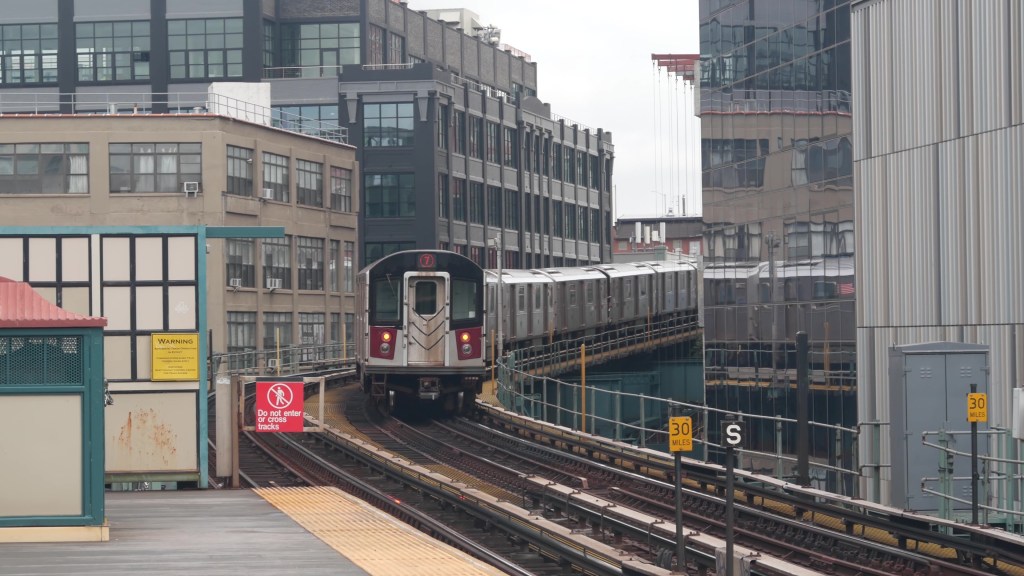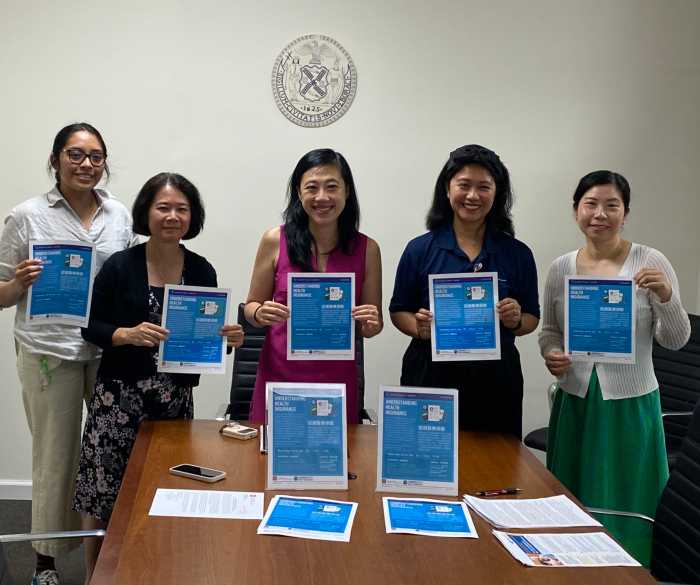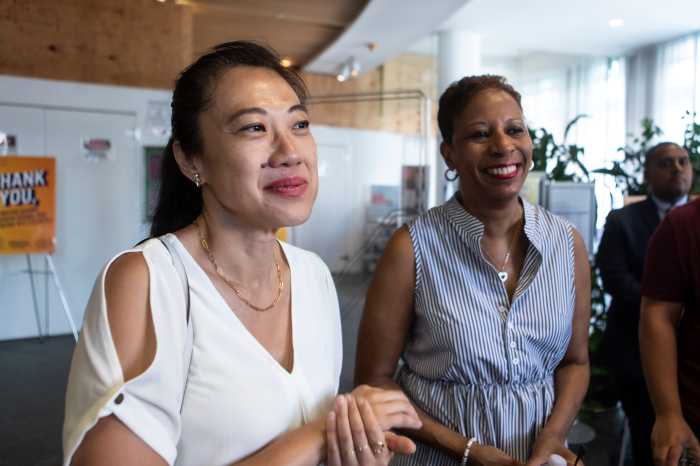Nilsa Ramos, a.k.a. “Cookie,” 47, has been HIV-positive for 20 years.
Ramos was living in Jamaica for 13 years before circumstances forced her out into the expensive and tight Queens housing market. During her search for a new home,…
By Alex Davidson
First in a series
Nilsa Ramos, a.k.a. “Cookie,” 47, has been HIV-positive for 20 years.
Ramos was living in Jamaica for 13 years before circumstances forced her out into the expensive and tight Queens housing market. During her search for a new home, Ramos still had to feed, house and clothe her six children, adhere to her medication regimen and deal with numerous city agencies to obtain her benefits.
After more than six months of looking at apartments in Queens, the Bronx and Brooklyn, Ramos found the place in Jamaica she now shares with two of her children — the other four live elsewhere. Her lease, however, is for two years, which means she may have to undertake another housing search very soon.
Ramos now lives far from public transportation and said she, like many other patients on medication to treat HIV/AIDS, has to cope with the drugs’ side effects, such as fatigue, while simultaneously fighting drug addiction, taking care of children and managing day-to-day activities.
To further compound matters, she and other people with HIV/AIDS in Queens who qualify for welfare must try to find a permanent home in a borough with few affordable housing options.
Ramos said the city HIV/AIDS Services Administration, or HASA, steers borough residents with HIV/AIDS out of Queens and into the Bronx and Brooklyn because that is where more affordable housing units are being built for city residents.
This puts people with HIV/AIDS in the awkward position of either moving to a new neighborhood where they have no friends and emotional support or staying in Queens with the possibility of ending up in homeless shelters or living in emergency housing.
“I don’t think we should have to make that choice,” said Ramos during a recent interview at the AIDS Center of Queens County headquarters in Rego Park. “A lot of people do not want to be traveling.”
The amount of money and type of housing the city provides for a person who is either HIV-positive or afflicted with AIDS depends on his financial situation and the status of his disease. This means, technically, that someone could afford a higher-priced apartment as her disease worsens because the city pays rent for most people with AIDS.
This changing situation with public benefits explains why people at different stages in their battles against HIV/AIDS are subject to the fluctuating housing market, which is so tight in Queens.
As of April 2003, there were 3,252 people with AIDS on public assistance in Queens, according to HASA, which accounts for 10 percent of the city’s total AIDS population. A total of 6,912 people have been diagnosed with AIDS in Queens, the city Department of Mental Health and Hygiene said.
Statistics on the number of people with HIV in Queens either on public assistance or living independently of government aid are not available because the city has only recently begun counting cases of people with HIV.
Jennifer Flynn of the New York City AIDS Housing Network in Brooklyn said people with HIV/AIDS in Queens do end up leaving the borough because of the housing pinch. She said despite the tremendous need for affordable housing in the borough, for those with HIV/AIDS on public assistance there is a “not in my backyard” mentality in Queens that stymies the construction of low-rent residential units.
In an audit report issued July 2, city Comptroller William Thompson Jr. said HASA is inefficient in processing clients’ housing applications and providing them with financial assistance.
“I am troubled by a number of weaknesses that make it difficult for HASA to find permanent housing for people with HIV and AIDS,” Thompson said. “People are looking to the city for help and instead are facing delays and roadblocks. This needs to stop.”
Said Flynn: “I think that there is a lot of organized community opposition to having housing for people with AIDS in Queens.”
Flynn said that once people leave Queens for housing in the Bronx or Brooklyn, they are cut off from their families as well as medical providers and are less likely to return to the borough.
Ramos is the exception when it comes to people with HIV/AIDS who are on public assistance finding housing in Queens. On the other hand, her $1,400-a-month rent, which is paid by the city, is still not cheap by most Queens standards.
Affordable permanent or rental housing in Queens is scarce, according to the city Department of Housing Preservation and Development’s 2002 Housing and Vacancy survey. The study found that the rental vacancy rate in Queens was only 1.78 percent, the lowest of the five boroughs, with just 7,658 units available for rent out of 430,864.
The vacancy rate citywide was higher as the price of apartments rose last year, according to the study. In other words, there are more units available for more money — such as the 4.76 percent vacancy rate in the city for units costing between $1,000 to $1,749 per month.
Faced with the high-priced housing market and frequent changes of address, people with HIV/AIDS from Queens receiving benefits congregate at HIV/AIDS service providers that they know are permanent entities in the community.
One such place is a church in Jackson Heights operated by The Momentum AIDS project. The facility at 33-50 82nd St. serves meals to about 90 people on public assistance every Tuesday and gives them pantry bags full of groceries to be used at home.
Robert Mauer, director of community relations for the Manhattan-based Momentum Project, said people come to the group’s Jackson Heights facility because it has a family feeling and is not threatening. He said it serves as an anchor for its clients, a majority of whom are coping with daunting problems such as finding housing, overcoming drug addiction or managing their virus.
“This is usually the first place people come. It gives them a place to go, a destination,” Mauer said. “This is a communal site; people know each other. Friends bring in friends.”
Mauer said Momentum rents churches throughout the city to give its clients a sense that the project is part of the community. He said people tend to come to community centers where they feel comfortable regardless of their location.
The face of people with HIV/AIDS and living in Queens has changed during the last 20 years away from homosexual, white males, Mauer said. And increasingly in the borough, the people coming to use the free food services offered by Momentum are heterosexual, minority women.
In Queens, he said, Momentum serves a large portion of undocumented people living with HIV/AIDS who are never counted in city surveys because they do not want authorities to know they exist for immigration purposes.
Some 90 percent of the clients at Momentum’s Jackson Heights site are Latino, Mauer said.
Johnny Tunstell, an HIV-positive peer advocate at Momentum who is from Jamaica, said Momentum serves as a refuge for people with HIV/AIDS in Queens.
“This is your escape from the hotels,” he said. “This could be your rehab.”
A 10-year client of Momentum, Tunstell described his experience living in HASA-provided housing in Queens. He said he would carry around gallons of bleach to sterilize the bathroom toilet seat and shower before he used them because he was worried about getting an infection with his impaired immune system.
Tunstell said he had to remain in temporary housing in a converted hotel because there was a lack of SROs, or Single Room Occupancy shelters, provided by the city in Queens.
Housing, however, is central to a person’s success in fighting his or her HIV/AIDS infections, Tunstell said, especially since a large portion of those with the illness are current or former drug addicts.
The city of New York is required by law to find emergency housing for people living with HIV/AIDS or assist people on public assistance with HIV/AIDS to find permanent housing. People with HIV/AIDS not on public assistance are supposed to find their own housing.
“Once you’re in stable housing, all the rest falls into place,” he said.
One ex-drug addict who has benefited from the stability offered by Momentum is Jane Doe, an HIV-positive transgendered person who moved to Queens 3 1/2 years ago. Jane, who wished to remain anonymous, now lives with her boyfriend in Whitestone.
Jane, once a practicing nurse who had to give up that career because of side effects from HIV-treatment drugs, said Momentum provided her with a community outlet where she could forget about her disease and other problems, such as trying to get her fair share of federal, state and city benefits.
“I love it; I don’t think there’s any place better,” she said. “This helped me to branch out and meet new people.”
Jane, 45, said Momentum’s Jackson Heights site is good for meeting people and talking with people who also are living with HIV/AIDS. She said she is trying to start a support group for transgendered people living with HIV/AIDS.
And she credits a lot of her success in battling her disease to Momentum and the people she met there.
“It’s like ‘Cheers’ without the booze,” she said.
Philip Glotzer, executive director of AIDS Center of Queens County, said HIV/AIDS service agencies managing clients also have to be responsible for their families. Glotzer said ACQC serves 2,500 people and factors in three dependents for each person, such as a spouse or child, bringing the total number of people served by the agency to 10,000.
This further complicates the search for housing, Glotzer said, because people with HIV/AIDS in Queens are increasingly people with children and need apartments or homes to accommodate entire families. He said people should not have to move away from their home borough just so they can find a place to live.
“That is really exacerbating the problem,” Glotzer said. “It’s taking the situation from difficult to impossible.”
Glotzer said it is difficult for people in Queens to battle HIV/AIDS if they relocate because they have to acclimate themselves to new schools, new apartments and new medical care facilities all at the same time. He said ACQC, like the city, has to look outside of Queens in the Bronx and Brooklyn to potentially house clients.
“Queens is one of the most difficult places to find affordable housing,” he said.
The HIV/AIDS Service Agency, or HASA, which is responsible for finding housing for people on public assistance with HIV/AIDS, has come under fire for not meeting the needs of its clients.
HASA was created in 2002 to replace the Division of AIDS Services. The agency is responsible for expediting access to benefits and services needed by people living with AIDS- and HIV-related illnesses and their families.
So Ramos, while gazing outside a window during a recent conversation with a reporter, wondered what would happen if she had to move again in two years once her lease ends. She defiantly said she would not leave Queens and instead would fight to stay in the borough with her friends, family and ACQC.
“It (ACQC) is a family. There is no one here that would deny you a hug or a kiss,” she said. “This is my second home.”
Reach reporter Alex Davidson by e-mail at TimesLedger@aol.com or by phone at 718-229-0300, Ext. 156

































